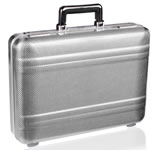Security-type attache cases, cash boxes, cash bags containing Dangerous Goods (eg lithium batteries, pyrotechnics etc).



.png)
Please note the following from table above:
| - |
Permitted in or as carry-on-baggage |
FORBIDDEN | |
| - |
Permitted in or as checked baggage |
FORBIDDEN | |
| - |
The approval of the operator(s) is required |
N/A |
|
| - |
The pilot-in-command must be informed of the location |
N/A |
Security Type equipment containing lithium batteries

Please note the following from table above:
| - |
Permitted in or as carry-on-baggage |
NO
|
|
| - |
Permitted in or as checked baggage |
YES
|
|
| - |
The approval of the operator(s) is required |
YES |
|
| - |
The pilot-in-command must be informed of the location |
NO |
The classification of "Security type equipment containing lithium batteries" covers a wide range of security type equipment and is forbidden, unless the following criteria is met!
1. Operator approval is always required.
2. The security equipment must have an effective means of preventing accidental activation.
3. If the item contains an explosive or pyrotechnic substance, it must not meet the IATA definition of a Class 1 (Explosives).
4. If the equipment contains lithium cells or batteries, these cells or batteries must meet the following restrictions:
- For lithium metal cells, the lithium content must not be more than 1 g
- For lithium metal batteries, the aggregate lithium content is not more than 2 g
- For lithium ion cells, the Watt hour rating is not more than 20 Watt hours (Wh)
- For lithium ion batteries, the Watt hour rating is not more than 100 Wh
- All cells and batteries must be of a type proven to meet UN standards (this generally means reputable brands of batteries only);
5. If the equipment contains gases to expel dye or ink, the following conditions must be met:
- The gas receptacle must only contain a class 2.2 gas (Non flammable Non toxic gas)
- The capacity of the gas receptacle must not exceed 50 mL
- The gas must not cause extreme annoyance or discomfort to passengers or crew
- The gas must be confined within the security equipment if accidently activated
- The gas, if activated, must not produce extreme noise
6. Security-type equipment that is defective or that has been damaged is totally forbidden.
Always check the current IATA DGR for expanded information. The Airline/Operator's Dangerous Goods Manual should also be checked in case there are variations.

